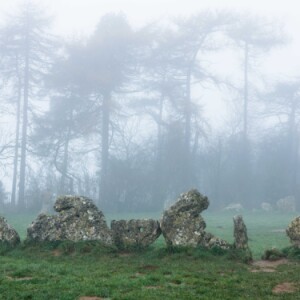Mossy
I went over to Oxfordshire this morning to have my hair cut. It was foggy and the car thermometer was registering just 2°C, so the drive wasn't as enjoyable as usual, but I made it there unscathed, despite a heart-stopping moment at a roundabout in Moreton in Marsh, when the driver of an articulated lorry apparently didn't see my little roadster until we were a good deal too close for comfort. With luck though he did manage to lip-read some of the epithets I uttered, as he emergency-stopped and I accelerated away to safety.
As it was still foggy when I left Chipping Norton, I thought it might be fun to swing round to the Rollright Stones and photograph them in today's rather spooky light. I last blipped this monument last December, in very flat light, and if you check out today's extra I hope you'll agree that the fog does add atmosphere to the scene. As I wrote about the history of the site then, I won't repeat myself here, except to recommend once again that you check out the the web site of the Rollright Trust.
While I was walking around the King's Men circle this morning I was increasingly drawn to the mosses and lichens growing on the stones, so I fetched the macro from the car, and spent about forty minutes examining them with more care, and photographing the ones I found most interesting. An information board nearby contains the statement that some of the lichens on the site are estimated to be between four and eight hundred years old.
Mosses and lichens stand quite high on the list of things I like but don't know much about, so anything I say from now on should be treated as unreliable, but I think the moss here is the Grey-cushioned Grimmia (Grimmia pulvinata), a very common lowland species that favours base-rich rock (which essentially means limestone). It forms neat cushions, 1-2cm tall, with capsules held on arched seta that curve back down into the bulk of the cushion when they're fresh, as you can see here. The ends of the leaves narrow and elongate into hair tips, which give the cushions a bristly appearance, and lead to the alternative common name of "hedgehog moss".
There are also several lichen in this image - black, yellow and grey. I've been able to identify some of the lichen I found today, at least tentatively, by their form and colour, or by the look of their apothecia (fruiting bodies), but there's nothing about these ones that gives me any clues. I'd like to make some return visits to the Rollright Stones in better weather, so that I can spend longer looking at the mosses and lichens - perhaps with a hand lens - and take more detailed photos, as a way of learning more about them.


Comments
Sign in or get an account to comment.


